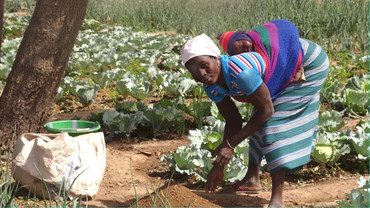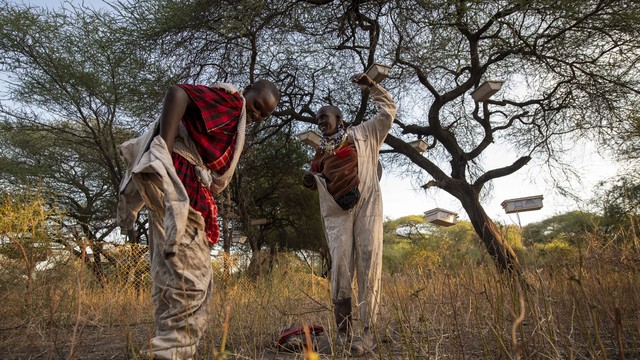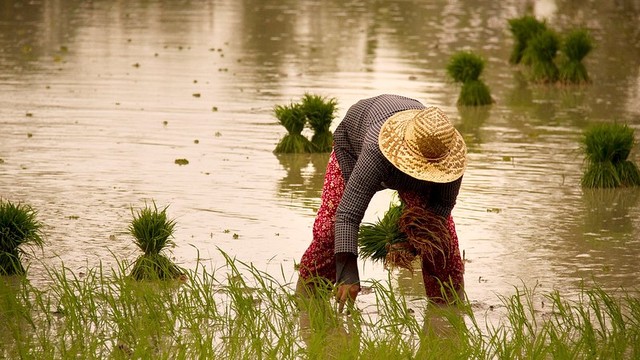Difficult choices: balancing competing priorities on Burkina Faso farms
The SITAM project looked at how to support progress towards sustainable intensification of agriculture in three African countries. This case study examines how farming households in eastern Burkina Faso are balancing different priorities as they try to increase their productivity.

Ready for harvest: a farmer and his wife in Bolontou standing in a field of mixed white and red sorghum (Photo: copyright ANSD/INERA)
Burkina Faso is in the Sahel region of West Africa. It has a fast growing population and an economy highly dependent on agriculture. The country is characterised by rain-fed subsistence farming. Agriculture, though highly dependent on the vagaries of nature, is emerging as the sector through which development can potentially be rapid and inclusive.
However, the country is struggling to eradicate poverty and ensure food security as well as adequate incomes for rural households. The vast majority of poor people in Burkina Faso live in rural areas and are food producers.
The farmers and their general situation
Our research took place in the Eastern Region of Burkina Faso. The focus was on two villages in two different communes: Bolontou in Tibga commune in the province of Gourma, and Pognankanré in Bilanga commune in Gnagna province.
We used a range of research tools to find out how farmers make decisions about their farming practices and livelihood strategies. To understand this in more depth, we looked particularly at 12 farm households – six in each village.
We followed the 12 households for one full rainy season to track their activities and choices related to farming and aspects of their livelihoods. We discussed with the farmers how they were managing trade-offs – what they were doing when there was competition between the various objectives they had for their family, household and farming activities. We visited them three times: at the beginning, middle and end of the rainy season.
How were the households chosen? Initially, we discussed with farmers in eight villages – four in each commune – how they defined ‘sustainable intensification’. Based on their criteria, we developed a quantitative survey, which we used for 138 households selected at random from these villages. We mapped the results and analysed how different types of households were performing according to different indicators.
Our aim was to try to show where on a pathway to sustainable intensification of agricultural each household was. Some farms were on a route towards greater use of fertiliser and mechanisation, others were adopting more agroecological techniques – they were using natural resources sustainably to increase their yields.
We selected the 12 households to represent different positions on that spectrum. We also selected richer and poor households to see what impact that had on the decisions they made.
Household characteristics vary
We found that household outlooks are different. Some families say ‘we want our children to go to school and get good jobs’. They only let school-age children help on the farm during holidays and at weekends, even if that meant producing a bit less – they didn't see their children’s future in farming although they would be pleased to see them come back to work on the farm as a hobby or weekend activity.
Where this happens, the family is investing in the future, building long-term diversity and resilience rather than in expanding the farm size in the short term.
I hope my children can stay in school and get a good job afterwards and those that become salaried only come back to agriculture by pleasure, because agriculture alone is not enough – farmer in Household 10, Bolontou
This outlook is not unusual, particularly in a context of climate uncertainty and change, and has led to rapid population growth in towns and cities in Burkina Faso: the proportion of rural to urban households used to be 80:20 and is now more likely to be 60:40.
In one household we spoke to, the farmer was away in another country for years before coming back with new ideas and a changed attitude. There were other households where there was no moneymaking activity on the farm in the dry season – anyone who could, would go to the city to find work.
There were no female headed households among the 12 we interviewed. This is largely due to social structures in West Africa. If a woman is divorced or widowed then she either goes back to her paternal family or she stays on in her husband’s extended family. If her husband was the head of the extended household, then another male would take over and the widow would stay under that household, hopefully with land still assigned to her to cultivate.

Members of one of the 12 households in the village of Pognankare standing in a field near their compound, which is visible in the distance (Photo: copyright ANSD/INERA)
And then there’s the question of children. In an agricultural setting, they are seen as an asset because they can be a labour resource. So any woman who leaves a rural household would be expected to leave children over seven years old behind. Even if she were financially independent or had the support of her relatives, she would be under huge pressure to hand them back when their father insisted or she wanted to remarry.
What are some of the important trade-offs that farmers are having to make?
The first trade-off: do you use herbicide and plant early to maximise your production or do you weed by hand, producing less but protecting the environment and your relations with your neighbours?
Some households had more land than they could work properly by hand, either because some family members were in town or because they were trying to increase production. In this situation, the farmers were using herbicide to clear fields of weeds to be able to plant early when the rains start.
Farmers did not have any training in the use of herbicides, nor were they using any protective clothing. Some of the herbicides used were toxic to livestock and aquatic life and were illegal but still available at local markets.
While using herbicide to save time was a gain in the short term, in the long term, it was polluting the environment, affecting grass growth and the quality of grazing land, soil and water and, perhaps most importantly, increasing social tension with neighbours fearing intoxication of their livestock.
A second trade-off is one that affects the whole village: do you increase land under agricultural crop production or reserve areas for livestock grazing? The former is an individual household decision but preserving land for livestock needs consensus and a governance framework at village level to put it in place.
If villages designate forests as grazing areas and stipulate that households can’t increase their farm area by encroaching on the forest, this could encourage farmers to put more focus on sustainable intensification. Villagers already showed quite a good awareness of agroecological farming techniques, following ongoing interventions from NGOs and the government and active advisory services, and many had started using them.
In one village four out of the six households were at least using soil and water conservation techniques and in the other, half of the households. But no farmer was following these approaches on all their land.
When grassland and forest grazing are in short supply, crop residues become a valuable feed source, leaving farmers with another trade-off to consider: do you prioritise soil fertility or livestock feeding? Farmers could let cattle graze freely on crop residues in their fields, leaving stumps, roots and manure in place to protect and improve the soil, or they could collect up all crop residues to feed livestock at home, leaving the soil exposed to the elements and removing nutrients.
Households may use millet stalks and manure as fuel, rather than spend money on fuelwood. It is possible to make good quality compost from the manure and return nutrients to the soil, but even wealthy households found it difficult to have access to the labour, transport or water needed for this. Without crop residues, manure or compost soil fertility continues to decline.
Mechanisation can help address labour shortages but raises other issues.
Trade-off four: Farmers wanted to prepare land quickly once the rains started, but also wanted to protect light, shallow soils from erosion. So do you plough all fields using bullock traction (regardless of soil type) to save time and effort or do you differentiate between soil types and plough light soils using donkey traction or continue to hoe them by hand, to protect them against erosion?
Government policy subsidises bullocks and bullock ploughs but even richer households who could afford this used donkey ploughs or hand cultivation on part of their land. Poorer households did not even have this choice.
Another trade-off relates to the use of farm produce: does a household keep all of its harvest, to maximise food security? Or does the household meet short-term needs by selling part of its harvest for cash, risking food shortage later in the season? Again, the poorer households had no choice: cash flow was an issue and they had no option than to take the short-term approach.
What needs to change?
There are some key policy recommendations for the national government in Burkina Faso (and the development agencies supporting it) that would reduce the trade-offs the farmers are having to make:
- Improve access to agricultural inputs such as subsidised seed or a range of appropriate semi-mechanical equipment to help households who have financial or labour shortages.
- Reconcile the twin objectives of crop and livestock production by implementing local land tenure charters that permit communities and local government bodies to secure and manage community grazing areas in a participatory and consensual way.
- Stop the use of non-approved herbicides by strict application of the laws on pesticide use and provide mechanisms for citizens to denounce farmers to the local authority.
- Support farmers to adopt more integrated agroecological farming techniques. This could include providing help such as wheelbarrows or carts in the dry season for constructing stone lines for filtering and slowing down run off to reduce erosion, as well as subsidies for organic fertiliser.
- And finally, support compost production by improving access to water (wells or ponds), transport (donkey carts) or by developing different ways of making good quality compost.
Additional resources
Supporting smallholders’ decision making: managing trade-offs and synergies for sustainable agricultural intensification, Barbara Adolph, Mary Allen, Evans Beyuo, Daniel Banuoku et al. (2020), International Journal of Agricultural Sustainability journal article
Trade-offs in sustainable agricultural intensification: the farmers’ perspective, Barbara Adolph (2020), IIED Briefing paper
IIED is working with partners in Burkina Faso, Ghana, Malawi, Senegal and the Netherlands on the SITAM project (Supporting smallholder farmers’ decision making: managing trade-offs and synergies for sustainable intensification).
Contact
Barbara Adolph (barbara.adolph@iied.org), principal researcher, IIED's Natural Resources research group



